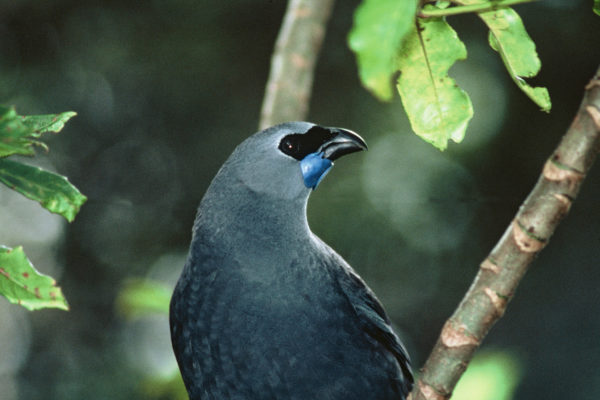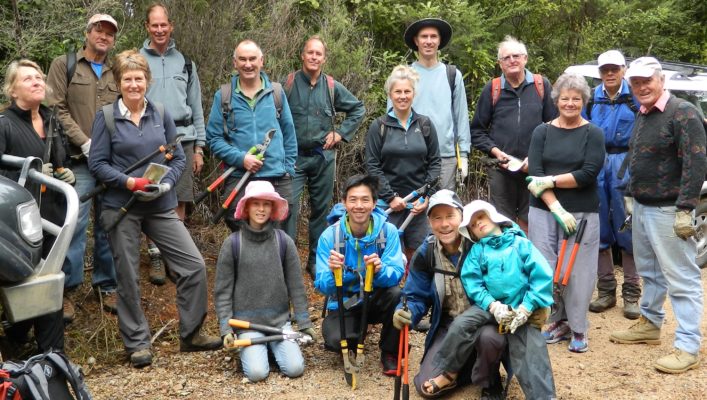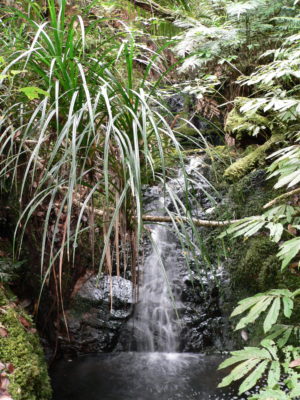The kokako are back and breeding successfully in Northland’s Puketi Forest, but it’s been a long battle to get them there – a battle fought by the Puketi Forest Trust in partnership with Iwi, the local community and the Department of Conservation, helped out by strong sponsorship support from individuals and philanthropic funders like Foundation North and Kiwis for Kiwi.

Puketi Forest is located in the heart of Northland. Along with Omahuta Forest, it forms one of the largest contiguous tracts of native kauri forest in Northland and is located close to the region’s main population centres of Okaihau, Kaikohe, Kerikeri, Kaeo, and Paihia. Over 100,000 people visit the forest annually.

“The Trust started in 2003, partly out of concern for the kokako,” says founding trustee and current chairman, Gary Bramley. “The remaining kokako were all male, so the population was functionally extinct and it was clear that other birds were in decline as well. Kakariki and kaka had recently disappeared. Kiwi counts were revealing a gradual, steady decline.”
At first, DOC tried bringing back young female kokako – a far from simple process as ‘speaking the local language’ is important in kokako breeding. The new birds needed to learn the local kokako dialect at the fledgling stage, before they were old enough to be released at Puketi. This meant that they needed to be reared manually and exposed to recorded song from Puketi before completing their ‘education’ on site in the target release area. A lot of time and specialist effort was invested in the rare and precious birds.
“The females were killed by predators as soon as they were released,” says Gary, “even before they were nesting. So we needed to do something. The public wasn’t keen on 1080 – they’re still not – and there wasn’t time to convince people about its benefits. Even pest control wasn’t universally accepted. Recognising we needed to act quickly we decided to use trapping and looked at the Te Urewera Mainland Island (TUMI) model. The TUMI approach is mainly based on trapping and we set about trying to implement something similar that would work at Puketi”
Initially stoats and cats were targeted by the Trust with trapping over an area of 5,500 hectares. The trapping area was rolled out over about three years and is still being increase. Intensive rat control was carried out over a portion of that area – about 650 ha in total. Possum trapping has also started recently. Currently there are a total of 1030 stoat traps and 249 cat traps in the 5500 hectare management area with 2456 rat traps and 2365 possum traps set out in the 650 hectare core area. There are also 830 bait stations.
“North Island brown kiwi call counts doubled initially,” says Gary, “but they haven’t increased recently. We get 4-6 calls per hour which is not high for Northland, where call monitoring can get as high as 28 calls per hour in some areas. We’re not sure why.”
Research is planned to find out why kiwi numbers aren’t higher. But other birds are thriving under the predator control regime.
“Our 5 minute bird counts (5MBC) doubled within the first few years” says Gary. “In 2009/2010 we reintroduced North Island robins. Now they’re established throughout the forest and doing well and we get records from throughout the forest. At our most recent robin monitoring in 2017 two of the original birds (released in 2009) were still around. They were the first robins in Northland for over 100 years,” Gary adds, “although the species was first described here.”
In 2013/2014 kokako were finally brought back to Puketi.
“Three of the kokako were descendants of original Puketi birds,” says Gary, “and another 20 were from Mataraua Forest, west of Kaikohe.”
So where did those descendants come from?

“Back in early 2000, when the Puketi population got down to 7 males, the advice from the Kokako Recovery Group was to catch and transfer the birds to predator-free Mauimua / Lady Alice Island as a holding pattern” Gary explains. “As part of that holding pattern, one male was sent to Auckland Zoo and one male to Hamilton Zoo where they were paired with females kindly gifted to Puketi from Kaharoa Forest. Those females had been taught the Puketi dialect and it was hoped they would breed in captivity. One bird from each of the captive pairs died, but not before the Auckland Zoo pair produced three chicks, two of which were also sent to Lady Alice Island. The third (a female) went to Hamilton Zoo to replace the Kaharoa female that had died. The birds that returned were the pair from Hamilton Zoo and one bird who appeared to be the sole survivor on Mauimua”
In the first few weeks after the release, acoustic anchoring – playing Puketi dialect recordings at regular intervals – was used to keep the newly released birds near the release location in Puketi Forest. In the second year (2014), when more kokako were released, the existing first-year birds were there to anchor the new arrivals.
“Rats and possums need to be less than 5% for kokako to breed successfully and survive” says Gary. “Because pest control was in place, the releases were successful. We’ve had evidence of breeding this year and last year,” he continues, “although we’ve not got a good population census for kokako so far. That will be the next job with pre-breeding calling monitored as the birds are pairing and establishing territory.”
Achieving predator control targets hasn’t been easy.
“We had to use poison in bait stations within the core area during the breeding season for the last five years” says Gary. “Rat numbers have been 8-10% going into the breeding season. When we set up the trapping network we also established a network of bait stations as a contingency. We’ve not had to use bait stations until the last few years, but it was worthwhile putting it in place early.”
Puketi Forest Trust has adopted best practice techniques, but has also carried out trials along the way to modify aspects such as baits used and spacing between traps.
“We adapt our techniques to suit each situation,” explains Gary. “Best practice is there for a reason but we look at the evidence for our particular situation. Every situation varies. If it looks like something needs changing we do a trial before making big changes.”
TIPS TO SHARE
When it comes to tempting predators, Gary advises that “you’ve got to mix it up.”
“In trials we’ve found that the bait which works best varies. We trialled Erayz (Connovation Ltd) vs salted possum. Salted possum seems to be working better for us, but we’re only part way into the trial. Earlier trials have shown that at some times of the year, meat is better for stoats; at other times eggs are. So we alternate eggs and meat for stoats throughout the year. Rabbit is the recommended meat bait for stoats, but we have difficulty sourcing enough cheaply. Possum works for us. For rats we have used chocolate buttons, peanut butter mixed with rolled oats, peanut butter alone and commercial lures from Connovation. We’re open to trying anything new, but we test it first to make sure it’s an improvement”
A second tip from Gary relates to the importance of monitoring.
“Keep up the monitoring, even though it’s hard when all of your group are volunteers and monitoring can be hard work. That’s where the money comes from. You need to be able to show funders what you are achieving.”
Monitoring at Puketi includes kiwi call counts and 5 minute bird counts as well as monitoring the success of predator control measures (rat tracking, wax tags and the like). But predators aren’t the only threat to Puketi. The ancient kauri forest itself is potentially at risk from kauri dieback.
Kauri dieback
“Puketi is the only major Northland forest – or one of the very few – which hasn’t got kauri dieback yet” Gary explains. “The forest has both milled areas which are regenerating and virgin kauri forest and the biggest threat is kauri dieback.”
The Te Araroa Walkway goes through areas of kauri dieback before reaching Puketi, putting the forest potentially at risk from hikers on the walkway.
“Best practice is to wash boots in trigene before entering a new area” Gary says, “But we don’t know if it’s 100% effective and nobody is policing Te Araroa.”
Pigs
Another big problem at Puketi is pigs.
“The hunting pressure is not high enough or consistent enough throughout the forest to keep pig numbers as low as we’d like,” admits Gary, “but local families also rely on pig-hunting to put food on the table so they are resistant to more sustained control”
Future translocations
Future hopes and plans include another kokako translocation to make the population viable.
“We’d probably need to extend our managed area by 1000 hectares for that,” Gary says.
Other bird species are also on the future wishlist.
“Warawara Forest near Kaitaia has a population of riflemen that are separate and distinct from other riflemen,” Gary explains. “The population is precarious and we’d like Puketi to be a backup for that population. Red-crowned kakariki disappeared from Puketi in the 1980s. Kaka and bellbirds visit occasionally and will probably establish on their own from offshore islands, but there is no nearby population of whiteheads…”
Kauri Challenge walk
Translocations are expensive however and, in addition to DOC funding and philanthropic sponsors, the Puketi Forest Trust holds an annual walk across the forest to boost funds.
“Those who do the walk get a 1-year membership of the Trust which includes receiving our newsletter three times a year, and many stay members,” Gary says.
It sounds like a great way to raise funds, increase first-hand awareness of Puketi’s beauty – and boost Puketi Forest Trust membership at the same time. The next Puketi Forest Kauri Challenge walk will be held on a Saturday, early in 2018 – date still to be confirmed. This year’s event was held in January 27.

